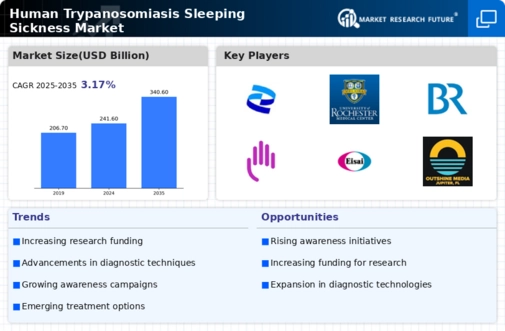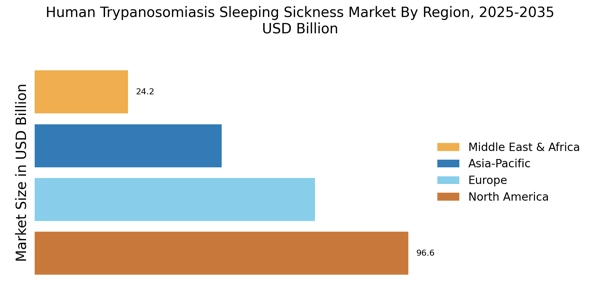Advancements in Treatment Options
Recent advancements in treatment options for Human Trypanosomiasis are poised to significantly influence the Human Trypanosomiasis Sleeping Sickness Market. The introduction of new therapeutic agents, such as fexinidazole, has shown promise in treating both stages of the disease. These developments not only improve patient outcomes but also enhance the overall efficacy of treatment regimens. Furthermore, the potential for combination therapies may emerge as a strategy to combat drug resistance, which is a growing concern. As healthcare providers seek to adopt the latest treatment modalities, the Human Trypanosomiasis Sleeping Sickness Market is expected to experience a shift towards more effective and patient-friendly solutions, thereby expanding market opportunities.
Technological Innovations in Diagnostics
Technological innovations in diagnostics are transforming the landscape of the Human Trypanosomiasis Sleeping Sickness Market. The development of rapid diagnostic tests and point-of-care testing technologies is enhancing the ability to detect the disease early and accurately. These advancements are particularly beneficial in remote areas where access to healthcare facilities is limited. Improved diagnostic capabilities not only facilitate timely treatment but also contribute to better disease surveillance and control efforts. As these technologies become more widely adopted, the Human Trypanosomiasis Sleeping Sickness Market is expected to expand, driven by the need for efficient and effective diagnostic solutions.
Rising Incidence of Trypanosomiasis Cases
The increasing incidence of Human Trypanosomiasis, commonly known as Sleeping Sickness, is a critical driver for the Human Trypanosomiasis Sleeping Sickness Market. Reports indicate that the number of reported cases has been on the rise, particularly in sub-Saharan Africa, where the disease is endemic. This surge in cases necessitates enhanced healthcare responses, including the development of new treatment protocols and diagnostic tools. The World Health Organization has noted that the disease affects thousands of individuals annually, which underscores the urgent need for effective interventions. As awareness grows and more cases are identified, the demand for innovative therapies and diagnostic solutions within the Human Trypanosomiasis Sleeping Sickness Market is likely to increase, prompting further investment in research and development.
Rising Awareness and Education Initiatives
Rising awareness and education initiatives regarding Human Trypanosomiasis are crucial for the Human Trypanosomiasis Sleeping Sickness Market. Public health campaigns aimed at educating communities about the disease, its transmission, and prevention strategies are gaining momentum. These initiatives are essential in regions where the disease is endemic, as they encourage early diagnosis and treatment, ultimately reducing morbidity and mortality rates. Increased awareness can lead to higher demand for diagnostic tests and treatment options, thereby stimulating market growth. As more individuals become informed about the risks associated with Sleeping Sickness, the Human Trypanosomiasis Sleeping Sickness Market is likely to see a corresponding rise in the utilization of healthcare services.
Increased Funding for Disease Control Programs
The allocation of increased funding for disease control programs is a pivotal driver for the Human Trypanosomiasis Sleeping Sickness Market. Governments and international organizations are recognizing the need to combat neglected tropical diseases, including Sleeping Sickness. This financial support facilitates the implementation of comprehensive control strategies, including mass screening and treatment campaigns. For instance, the World Health Organization has initiated various programs aimed at reducing the incidence of the disease, which directly impacts the market by increasing the availability of diagnostic and therapeutic resources. As funding continues to grow, the Human Trypanosomiasis Sleeping Sickness Market is likely to benefit from enhanced infrastructure and improved access to care for affected populations.


















Leave a Comment